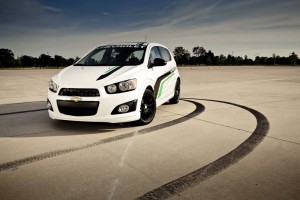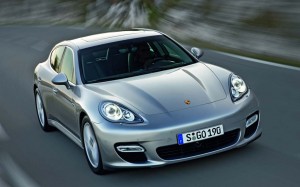With an engine of just 1.4 liters in displacement under the hood one might expect the Dodge Dart Limited to fall into the “stone pony category.” But while the maker clearly wanted to downsize the new sedan’s powertrain in order to improve mileage it was clear there wouldn’t be much demand from consumers if that also meant a serious sacrifice in the performance column.
And there isn’t, the so-called Tigershark engine turning 0 to 60 times in the mid 7 second range, comparable to some compacts using much larger – and decidedly less fuel-efficient V-6s. Chrysler engineers recognized early on that there was one cost-effective way to deliver great mileage under routine driving conditions yet still maintain performance when the demand was there: with a device known as a turbocharger.
And the smallest of the Detroit makers isn’t alone. From some of the smallest models on the market, like the new Chevrolet Sonic, all the way up to ultimate performance machines like the Porsche Panamera Turbo S, turbochargers are coming into increasingly high demand across the auto industry.
“With fuel prices being a significant concern for consumers and businesses, turbochargers are a smart choice for getting more miles to the gallon,” says Tony Schultz, Honeywell Turbo Technologies’ vice president for the Americas.
Tubochargers are expected to show up on an estimated 3.2 million commercial and passenger vehicles sold in North America this year, a 1 million unit jump from 2011, according to Honeywell.

Turbos allow a maker like Chevy deliver more mileage without a loss of power using a downsized engine in models like the Sonic.
It is all but impossible to find a diesel engine that doesn’t use the technology and it is becoming increasingly common on gasoline powertrains, as well, adds Rick Balsley, the head of the General Motors unit developing turbochargers and superchargers. At GM, he notes, 7% of the vehicles it expects to sell in the U.S. this year will use turbos and that figure – already marking a sharp increase from the end of the last decade – is expected to jump to 10% in 2013.
One of the easiest ways to generate more power from an engine is to force more air into its cylinders prior to ignition. Turbos are, at their simplest, little more than an air pump designed to do just that. There are two key components, one a fan blade that is powered by exhaust gases spewing out of the engine. In turn, that spins another fan that compresses fresh air and forces it into the engine.
The basic concept has been around since 1925 when it was conceived by Swiss engineer Albert Buchi. And the first exhaust gas-powered automotive turbo showed up on the 1962 Chevrolet Corvair.
The technology was relatively rare until the 1980s when sports car makers began to discover the turbocharger’s ability to generate significantly more power out of an otherwise small engine. But models like the Ford Probe, Saab Viggen and Mitsubishi Eclipse also experienced a variety of problems.
Because it can take a second or three to “spool” up their spinning turbines turbos of the 1980s and ‘90s routinely experienced a dismaying effect known as “turbo lag.” A motorist would stomp on the throttle and wait until power suddenly came on, almost like a fighter jet’s afterburners kicking in. On some models that would lead to an unexpected lurch to the left or right.
Meanwhile, early turbos were prone to overheating once the car was turned off, causing oil “coking” that would jam the ports used to lubricate the main bearings. Premature failures were, on some vehicles, the norm rather than the exception.
Engineers today have all but eliminated both these problems. So-called thermo-siphons wick away heat to reduce warranty problems, while more sophisticated designs like the new twin-scroll turbos on the BMW Z4 largely overcome turbo lag.
But perhaps the single biggest breakthrough was the development of microprocessors small and powerful enough to adjust the settings of the otherwise mechanical devices, sometimes at a rate of thousands of commands a minutes.
Today, it’s hard to find an automaker that isn’t using turbocharging on at least a few models. It’s the centerpiece of Ford Motor Co.’s new EcoBoost engine family which, the maker plans, will be available on 80% of its product lines by mid-decade.
Along with a conventional, or naturally aspirated V-6 engine, the EcoBoost six available on the Ford F-Series pickups now accounts for more than half of the truck’s sales.
A forecast by consulting firm LMC Automotive predicts that turbochargers will be used on a full 23.5% of the vehicles sold in the U.S. by 2017. As recently as 2008 the figure was a mere 2%.
One reason behind that surge is that turbochargers are far less expensive than hybrids and even more complex battery drive systems that might otherwise be needed to improve fuel economy, says Honeywell’s Schultz.
“It’s a proven technology that can be used across market segments and does not put the consumer in an extended payback period like other technologies to realize its benefits,” he says.
The technology isn’t free. The most sophisticated systems can add thousands of dollars to the price of a vehicle like the 200 mph Panamera Turbo S. But less advanced turbochargers are more than cost effective, according to GM’s Balsley and other industry officials – especially if they allow a maker to replace a V-6, say, with a turbocharged four-cylinder engine.
In fact, many industry analysts believe that the long-term trend in the U.S. auto industry is to downsize engine sizes rather than the vehicles motorists choose.
It’s important to recognize that simply bolting a turbo onto an engine isn’t a panacea, stresses Balsley. “If I take two engines of the same size and put a turbo on one of them the fuel economy won’t get better,” though it will develop significantly more power.
And for those who use a turbocharged engine aggressively – as is typical with a sports car – fuel economy savings might be significantly less than projected for less performance-oriented drivers. But on the whole, automotive planners believe that the benefits of turbocharging are significant, leading some to suspect that even the more optimistic growth forecasts will ultimately underestimate the growth trend.


Just bought a Buick Regal with the 220 hp turbocharged engine. Fun to drive and quick, considering there is a lawnmower-sized engine in the front. Smooth power in all ranges and great fuel mileage, as long as I withhold the temptation to mash the accelerator! Haven’t had this much fun with a car in years; love the way it handles too. I can only imagine how much of a kick the 260 hp version has, but this is enough for me.